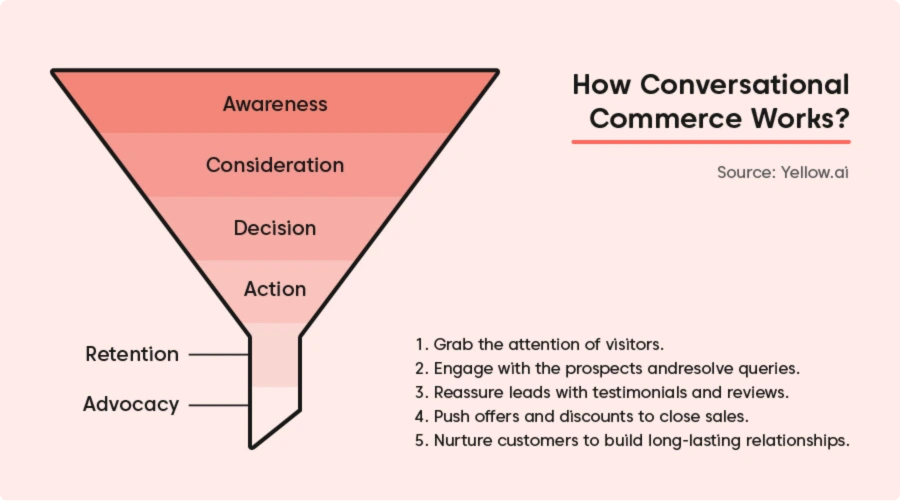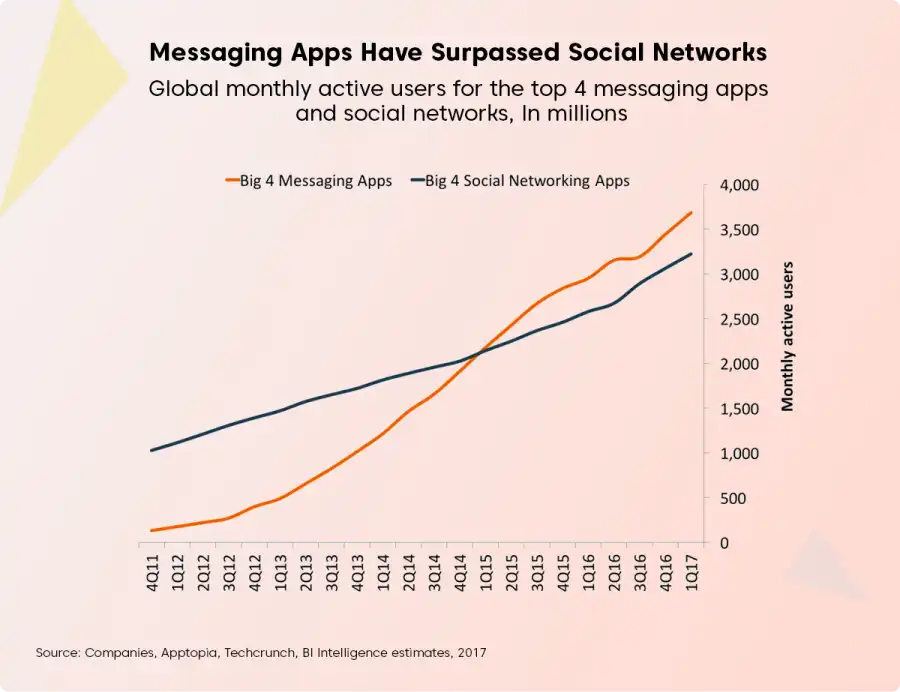With the rise in messaging apps and voice assistants such as Alexa, Siri, Google Assistant and more, customers have become accustomed to everything on-demand. Infact, 86% of customers expect a more convenient, proactive and personalized experience, when interacting with businesses online and this is something that conversational commerce can easily achieve.
their journey and convert faster.
What is conversational commerce?
Conversational commerce is a term coined by Uber’s Chris Messina in 2015 which refers to the intersection of conversation and selling. It is when brands make use of AI-powered technology such as live chat, chatbots and voice assistance to sell their products and services. It’s a two-way street that enables customers to interact with merchants in real time and provides companies with a one-to-one sales channel.
No doubt why it’s emerging as a way for brands to add a human touch to their online sales strategies while customers react positively to the experience. Recent research even shows that customers from all age groups prefer the assistance of a chatbot to make an online purchase. Also, 65% customers feel comfortable with the self-serve feature of C-commerce that allows them to self-resolve issues with the help of conversational AI.
How does conversational commerce work?
Customer journey spans across 5 stages of awareness, consideration, decision, action and retention. Here is how conversational commerce opens a dialogue between you and your potential customers so that you can interact with them at every step in their journey

1. Awareness
The first and most important stage of the buying process is when a customer becomes aware that they have a need for a product or service. Even if consumers aren’t aware they have a need, you can still create awareness by showcasing your products or services. Improving the relationship with your customers and creating your brand name is more important, and about 59% of buyers are likely to buy a product from a brand they are familiar with, so getting on board with conversational commerce will increase the familiarity of your brand.
2. Consideration
Now that a customer is aware that your product or service can fulfill their needs, they will look forward to gaining more information about your offerings. They may have some queries and you will have to respond quickly as 82% of customers expect immediate responses. Conversational commerce tools enable you to stay available for your customers on their preferred channel 24*7*365 and provide instant answers to their questions.
3. Decision
This is the stage where customers tend to get distracted the most. They may be convinced that your product or service is suitable but they will also be inclined to look for better offers. This is when you jump in and reassure the customers that your offering is the best. You can send testimonials and reviews to the customers via chatbot and encourage them to choose you over your competitors.
4. Action
Even when the customers have made their purchase design, they may need some extra push to complete the purchase. conversational AI tools can help you push tailored offers, coupons and discounts to close the deal faster.
If the customer abandons the cart, chatbots will automatically follow up with them and instill a fear of missing out by reminding them that the product may run out of stock soon or that the offers will only be valid till a certain date.
5. Retention and Advocacy
Harvard Business Review estimated that retaining a customer is 25% more costlier than gaining a new customer which is why engaging with customers only till they make a purchase is not enough. After making the purchase, some buyers may have a buyer’s remorse or issues which can impact your brand’s trustworthiness. At this stage your interaction with the customer will seed a sense of satisfaction and help boost customer loyalty and retention.
What are the types of conversational commerce tools?
1. Live Chat Software
Live chat software is the most preferred feature used by eCommerce websites. This helps the customer to get quick and hasslefree responses from a live agent without submitting any form, sending an email or calling. Live chat software allows the agent to deal with multiple cases rather than dealing with a call at one time. This will reduce the waiting time for the customer and increase the sense of sticking around and being together in the journey.
Live chat can be reactive or proactive in nature, which means that either you can break the ice by sending a welcome message to the customers or the customers can get in touch with you with their issues. Either way, live agents can act as personal shoppers that can help customers pick the right product from the endless listings on your store.

2. Chatbots
Chatbots are effective self-service tools that solve customer problems without much human intervention. Infact, chatbots can single-handedly resolve 80% of customer queries and free-up agents’ time to focus on more pressing customer issues.
Also, intelligent chatbots of today are backed by technologies such as AI, machine learning, NLP and more that enable them to understand customer intent and deliver personalized support. They’re available round-the-clock and provide human-like-support to your customers.
3. Messaging Apps
Messaging apps are increasingly becoming the most preferred way for customers to interact with businesses. Over three billion people have used messaging apps in 2021, making them one of the most popular app types. For most people, mobile messaging consists of two platforms: Facebook Messenger and WhatsApp. In order to improve customer experience and make more sales, you need to meet customers where they are and automate engagement across these platforms.

4. Voice Assistance
“Alexa. Book an appointment for the dentist today.” Yes, that’s how easy it is these days to book an appointment. Not only this, virtual assistants such as Alexa, Siri, Google Assistant, etc are making everyone’s life easier by handling time-consuming, redundant tasks. Using voice assistants in your marketing and customer service strategies can help you boost your brand awareness. They are convenient, they are fun and most of all, they save your customer’s time.
Steps for getting started with conversational commerce
Building and setting up a conversational commerce strategy is a time-consuming process and needs a lot of thought behind. It can be overwhelming, especially for small and medium businesses, to enable conversational commerce on all platforms at once with absolute perfection. Businesses need to move forward in the journey following a step-by-step procedure.
1. Analyzing business needs
It is very important to understand the pain points of your customers before building an automated conversational commerce platform. It will help you set realistic goals and resolve major customer issues. For example, if your e-commerce platform has too many product options and customers are unable to select appropriate products, you can help them by listing relevant products as per their preferences.
Prioritizing these goals is also crucial as it allows businesses to set a timeline and analyze the impact of each and every step towards conversational commerce.
2. Researching for solutions
Setting up conversational commerce is not an inexpensive process. Businesses need to measure the pros and cons of each and every solution in the marketplace. They should take demos and sign up for free trials before subscribing to solutions and select the best one for their business.
A comparative study about how other businesses are using conversational commerce can help you set a benchmark and understand customer expectations. You can then select a tool and move forward with enabling and automating conversational commerce.
The process is to build a platform that satisfies customers. Businesses can conduct short user interviews to understand their current needs or take reviews to find out the possibilities and scope of improvement.
3. Identifying a conversational partner
Implementing a conversational commerce tool needs a team of specialized people, experts in conversational flow design and management of different integrations. A business trying to implement the conversational tool needs to understand the technicalities and select the right tool for its team.
For example, if you do not have a large team to provide live chat access to customers, you might need to opt for an AI chatbot. This will help your business provide instant responses and satisfy customers.
Businesses can choose to find an agency or a conversational partner that understands the requirements and curates a conversational commerce channel personalized for the business.
4. Launching a conversational commerce platform
Once the implementation of a conversational commerce tool is complete, businesses need to think about their key performance indicators (KPIs) and metrics. These can be the number of conversations, satisfaction scores and conversion rates. KPIs are very important to calculate the ROI of the tool and measure the success of conversational commerce.
Once a business sets KPIs and has thoroughly tested the conversational flow, the platform is ready to be launched.
5. Measuring success
Improvements in customer experience are only possible when businesses track real-time data and derive useful insights. No matter how tight or refined your conversational commerce tool is, there is always a space for improvements.
Measuring success (or failure) of conversational commerce in making informed decisions about supply chain, marketing, promotions and even customer service.
Benefits of conversational commerce platform
1. Enhance customer service
The key to customer retention is excellent customer service. By focusing on giving customers what they want, companies can truly enhance their overall customer experience. Having said that, customers today demand to connect with a brand across multiple channels.
With the help of conversational commerce solutions, businesses can unlock a seamless omnichannel experience to improve customer loyalty, drive sales and revenue.
2. Optimize customer service costs
Modern customers are always on-the-go and hardly have time to stay on hold or wait for a response. On the other hand, businesses spend over $1.3 trillion every year to proactively respond to customer requests. With the help of conversational AI, businesses can reduce their customer service costs by up to 30% and customers will be able to get quicker and more consistent service.

3. Personalize customer experience
Customer service is all about convenience. Providing personalized suggestions to the customers can reduce the time they spend searching for a suitable product.
A c-commerce solution with the help of technologies such as natural language processing (NLP) and customer intent recognition can help chatbots understand customer behavior to make relevant recommendations.
4. Improve conversion rate
Businesses spend a lot of money to get customers on their website, but what happens once the customers arrive? Will they be supported every step of the way by an intelligent AI assistant or left to scramble their way through the website? Well, the former option is the better way to go.
By using the right c-commerce strategy, businesses can increase their conversion rates significantly. Even without having the most-optimized website.
5. Reduce cart abandonment rates
Cart abandonment implies that a customer added products to the cart but left the website without making the payment. There can be multiple reasons for cart abandonment like forced account creation, long delivery times, hidden costs, etc.
That’s where chatbots can play an important role. Chatbots can reduce cart abandonment by 20-30%. They can follow up with hesitant customers regarding their abandoned carts and encourage them with offers and discounts to complete their purchase.From resolving queries, sending in-app notifications, to engaging users by providing a personalized shopping experience, c-commerce tools can help you get those final conversions

Conversational Commerce Use-Cases
By the end of 2025, the conversational commerce business market is expected to reach $14 billion. If you’re also looking to adopt C-commerce, here are some of the most popular use cases:
1. Product discovery and recommendations
It can get tedious for customers to choose the right product from the endless listings on an eCommerce site. With conversational commerce bots, you can help customers to make the right choice.
For instance, you are an insurance provider and a customer asks you for policy recommendations. Your NLP powered insurance chatbot will do all the work for you. It will gather the required information and documents from the prospect and present them with all the relevant recommendations to choose from. All without the intervention of a human agent.
This, in turn, narrows down the choices for the customers and they can make their decision in much less time. Conversational AI with sales functionality can help bring in more direct sales, as customers buy directly from the chatbot interface.
2. Pre and post-sales support
Pre-sales support is all about making sure that the customer completes the purchase without any hassle. Post-sales support is just as important.
Once the customer has bought a product from your eCommerce site, they may want to return/exchange it, leave a review about it or inquire about the status of delivery. With the help of in-app notifications, live chat and voice or chatbots, you can keep customers engaged and achieve their loyalty.

3. Cross-channel engagement
A research by Bain & Company found that What transforms a multichannel customer service approach to an integrated omnichannel strategy, it’s the cross-channel engagement. This means when customers switch from one channel to another, there is no loss of information and the customers won’t have to repeat their problems to multiple people again.
A chatbot that is integrated with your internal and external ERP systems can extract customer data and use it to deliver connected experiences. This in turn shortens the sales cycle and improves customer satisfaction.
Just like Leo Coffee, one of the most popular coffee brands in India, expanded sales of its delicious coffee blends with the help of Leo – The Intelligent Virtual Assistant.
Yellow.ai helped Leo Coffee by deploying an interactive UI bot across multiple channels like Facebook, WhatsApp, and Leo e-store. This intelligent virtual assistant helps customers choose the right blend according to their preferences and helps them subscribe and order the pure blends, right from the bot interface.
Read the complete case study by clicking here.
4. In-chat payment integration
Now customers won’t have to switch between channels to complete a purchase. When a chatbot makes a product recommendation to a customer, it can also provide an option for them to buy it from the chat interface itself. Accepting payments via chat can help save customers time and improve their overall experience.

5. Secure co-browsing
Co-browsing or collaborative browsing enables live agents to assist customers by acting as their personal shoppers. It basically allows simultaneous navigation of any web page by agent and the customer. Co-browsing combined with other applications such as video chat lets the agent provide a human touch to the online shopping process. Also, co-browsing is completely secure, as during the session the agent can not see any other data on the client’s device. The customers will need to approve the request before the agents can start the co-browsing session.
How can brands adopt conversational commerce?
The future of conversational commerce looks promising. Both the customers and businesses are bound to benefit from the adoption of c-commerce. To help you get started, here are 4 steps to adopt AI conversational commerce for your online business.
1. Pick an achievable goal
Identify a business goal or a challenge that you want to resolve with the help of conversational ai. For instance if your goal is to enhance customer loyalty, you might want to provide friction-less, real-time support to your customers.
Whereas, if your purpose is lead generation, deploying chatbots on Whatsapp business or Facebook Messenger can be the way to go.
2. Do immense research
The best way to come up with the perfect c-commerce strategy is to analyze your customers’ pain points. Once you identify what’s driving your customers away or what’s important for them, you will be able to make the right decisions.
For example, 12% of Americans rate their number one problem with customer service as lack of speed. If your customers face the same problem, you can use conversational AI to resolve customers’ queries quickly and efficiently.
3. Choose the right technology partner
Conversational commerce is not just about deploying bots, it’s about a wider conversational strategy that will allow your business to create more meaningful customer experience. You will need a technology partner with the right platform, industry expertise and knowledge to be able to turn your business goals into reality.
4. Launch, measure and optimize
When you’re ready to deploy your conversational commerce tools, it’s important to decide what your key performance indicators (KPIs) are. Your KPIs will help you monitor your growth, measure your performance and optimize shortcomings.
Some great examples of KPIs are customer satisfaction score (CSAT), conversion rate or cart abandonment rate. You can determine your KPIs based on your specific business goals.
Ways to integrate conversational commerce into your marketing
Using conversational commerce is the new way to market products from your virtual store. From websites to social media, all the platforms can be well-integrated with conversational AI tools and can be leveraged in upselling, cross-selling and marketing products.
Let us look at some ways to use conversational commerce along with marketing and reach out to customers with products of their choice.
1. Deploying live chat on the website
Continuous customer engagement and instant messaging can help your e-commerce business to elevate marketing to a new level. With the help of chatbots or real-time representatives, businesses can interact with customers, help them with the products of their choice, offer some discount coupons or promotional codes and allow them to complete their buyer’s journey seamlessly.
In addition to interacting with customers, conversational commerce tools can also be integrated with multiple CRM software as per the needs of the business. This makes the use of chatbots easier and smoother. Businesses can pull data from multiple sources and get a comprehensive view and detailed insights.
2. Building chatbots
Businesses can build their own chatbots for platforms like Twitter, Messenger or even websites. With little or no technical support, businesses can design conversational flow and enable seamless communication between businesses and customers. These chatbots can be used to resolve customer queries and meet customer expectations of instant responses.
Chatbots can also be integrated with multiple CRM software so as to get a unified and detailed view of customer conversations. With the help of the data and insights, businesses can make informed decisions about customer engagement, support and experience.
3. Stepping up social media marketing and monitoring
With customers rushing toward social media for shopping, businesses need to step up their social media marketing and monitoring efforts. Enabling conversational commerce on social media can be a great step toward achieving more revenue. The process to do that is very simple and can be completed with the help of CX automation companies.
For example, businesses can enable conversational commerce on WhatsApp by using WhatsApp Business API and automating the complete buyer’s journey on the social platform.
5 Examples of Conversational Commerce
Businesses across the globe have shown tremendous results by deploying a conversational commerce tool. Some of our e-commerce clients including Sephora, Zalora and Kitabeli have delivered millions of seamless shopping experiences leveraging conversational AI.
Let us look at some practical examples of conversational commerce being used in businesses and understand the results.
1. Anchor & Crew
A British bracelet and accessories manufacturer uses live chat as a conversational commerce tool and allows customers to purchase products online. Anchor & Crew also use the live chat software to share promotional offers and clearance discounts in real-time.
For example, a customer visits the website for the first time. They receive a nice greeting from the live chat software and a promotional code for their first purchase.
2. Amazon Alexa
Amazon makes buying easier for customers by leveraging “Alexa”, an AI-powered voice assistant, that is a utilitarian tool for houses. It can be connected to all the devices at home and let users control them through voice commands.
Apart from this basic use case, Alexa is widely used to shop products from Amazon. It can help customers revisit their abandoned carts and complete orders through voice commands.
3. Starbucks
Starbucks has dedicated a separate chat window on their mobile application for customers to order their morning coffee. This “virtual barista” lets its users place orders and pay through the app so as to streamline the entire sales process.
The online ordering process has positively impacted the customer experience as customers now don’t need to wait in long queues in the morning to place and receive their orders.
4. H&M
The brand has a unique level of personalization in conversational commerce. They interact with customers using a messaging app called Kik, which is a chatbot available for customers 24×7. H&M focuses on delivering an experience similar to the in-store experience by offering stylist recommendations. These recommendations are based on customer preferences and their previous choices.
The chatbot allows a lot of customer engagement and enable the business to collect customer data. In addition, the chatbot is highly user-friendly and allows customers to interact in a very casual language, making the customer experience further better.
5. American Leather
A Texas-based leather furniture brand trying to make the furniture shopping experience to a whole new level. American leather enabled conversational commerce in order to respond to customer queries about the products instantly.
The brand implemented and used the chatbot furthermore by allowing customers to know about their order status, view order invoices or receipts and check warranty terms.
Conversational commerce must be, by nature, omnichannel
Conversational commerce can open floodgates of opportunities for businesses. With conversational commerce, you can replicate the in-store experience with personal shopping assistants on every channel and provide an exceptional virtual shopping experience to your customers.
Conversational commerce can become as good as you make it. If you can deploy a tool on each and every communication channel and offer a delightful experience to your customers from every channel, they are bound to be satisfied and re-visit at the time of need.
Omnichannel conversational commerce ensures a unified and consistent experience throughout the buyers’ journey. Customers can place orders, get invoices and request support using the channel of their choice. Businesses can enjoy the benefits of having detailed insights and data without silos.
Why is conversational commerce the future of eCommerce?
If there is one thing that traditional E-commerce lacks, it’s the online equivalent of the helpful store associate. According to a recent survey by Tulip Retail, 79% of customers say that engaging with a knowledgeable store associate is “important” or “very important”. C-commerce bridges this gap and enables businesses to offer real-time personalized support to their customers throughout their online shopping journey.
If you are also looking forward to making your online business future-ready, here is how Yellow.ai end-to-end conversational commerce automationsolutions can help you.
- Engage your customers wherever they are, through conversational virtual assistants, across text and voice, for faster conversions, higher CSAT, and lasting loyalty.
- Unlock a whole new ‘live-commerce’ channel where the customers can directly interact with an agent using our intuitive chat and video interface.
- In-app notifications
- Create timely and multilingual campaigns to rejig customer interest with personalized conversations on the channel of their choice to boost revenue.
- Video calls
- Connect, engage, direct and convert your customers anywhere, anytime without the older restrictions of ‘online’ or ‘in-store’.
Ready for the future of conversational commerce?
Conversational commerce is the new way to interact with customers and engage them with the brand. Businesses need to re-think their customer engagement and virtual shopping experience on the grounds of real-time communications via chatbots, voice bots and messengers. They need to break the silos and fetch data that is accurate, unified and result-driven.
The future of e-commerce lies in the business’s ability to adopt newer technologies and make shopping easy and therapeutic for customers, and conversational commerce is the key to doing it.
Frequently asked questions
Conversational commerce allows for two-way interaction between brands and consumers via messaging apps, live chat or chatbots and voice technology. M-commerce on the other hand is the buying and selling of goods and services through wireless handheld devices such as smartphones and tablets. Both of these are the more advanced types of E-commerce models that allow customers to interact with businesses anytime and anywhere.
Customer support has evolved in numerous ways, from keeping customers on hold to responding to them immediately, support has come a long way. Conversational support is a niche term that refers to the ability of businesses to provide support over messaging platforms. This means instead of calling a company, customers can easily get in touch with them over messaging platforms like WhatsApp and Facebook Messenger.
According to TechTarget, “Headless commerce, also called headless e-commerce, is a platform architecture that decouples the front end of an e-commerce website with the back end. The front end, or the “head,” is typically a content management system (CMS) or digital customer experience delivery (DCED) platform that stores, manages and distributes content. The back end is the e-commerce platform that provides the purchasing logic, data and capabilities. This headless approach combines the customization of a CMS with the security of a software as a service (SaaS) e-commerce platform.”
Headless commerce architecture is built for the IoT age where developers can use APIs to deliver things, products, content or customer reviews to any screen or device. Traditional commerce on the other hand has a predefined front-end that is tightly integrated with back-end, so it is only designed to deliver content in the form of websites and maybe native mobile apps.
Conversational AI technology combines natural language processing (NLP), machine learning and AI with traditional conversational softwares like chatbots, voice bots and live chats to make them more intuitive and sophisticated. Conversational AI has multiple use cases across business functions like HR, ITSM, customer support, sales and marketing. On the whole, it bridges the conversational gap between brands and customers, and helps build long-lasting relationships.
E-commerce, or electronic commerce, refers to the activities of buying and selling products and services with the use of electronic systems such as the internet. M-commerce is an extension of E-commerce mCommerce that refers to the process of buying and selling products and services with the use of internet/cellular data via wireless handheld devices like phones and tablets. The key differences between the two are:
- Lack of mobility in E-commerce as customers prefer to use mobile phones over computers to shop online.
- M-commerce leverages various positional tracking technologies on the mobile phones of users, such as GPS, WiFi, and cellular connections whereas, the only metric used to track e-commerce shoppers on computers is the IP address.
- M-commerce can reach a wide range of users with the help of push, even when they’re on the go.
- E-commerce websites on desktop can be hard to navigate as compared to on the phones.
















